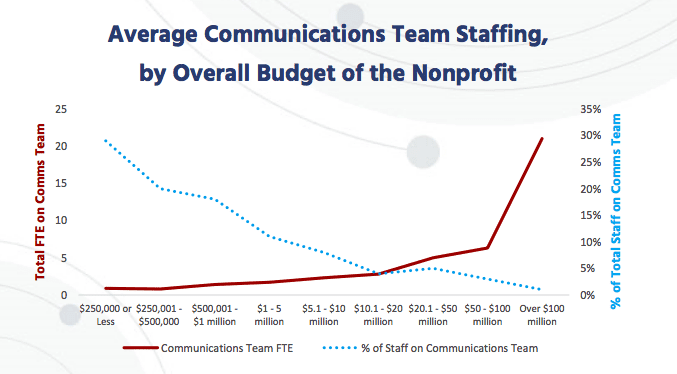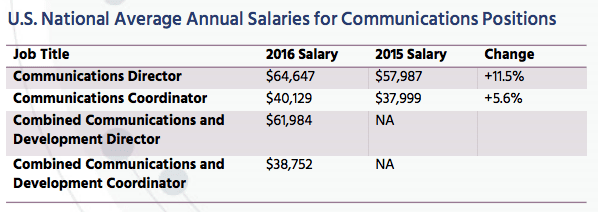In part one of this series, we introduced a few of the deadly sins nonprofits (and those who support and influence them) commit in regard to their marketing, fundraising and communications budgets.
As anyone who works in the sector knows, nonprofit budget decisionmaking is complex. Even the most sophisticated, well-intentioned organizations make mistakes due to pressure or poor direction from their funders, board members, leadership staff and others, and there are few areas of a nonprofit budget that feel the impact more than marketing.
Here are the four remaining marketing budget sins we see most frequently among nonprofits.
Deadly Sin #4: You’re Underinvesting in Your Nonprofit Marketing Talent
Talent is, without a doubt, the most important component of any nonprofit marketing and communications effort. Your staff salaries should always be the biggest line item on your nonprofit marketing and communications budget. But even if you’re already spending more on staff than on advertising, partnerships and other paid efforts, there is still a good chance you’re underinvesting in your nonprofit’s marketing talent.
There are two ways this deadly sin typically presents itself: through a team that is too small to address the needs of the organization or through staff salaries that are too low to attract and retain top talent.
In their 2017 Nonprofit Communications Trends Report, The Nonprofit Marketing guide found that the least effective nonprofits devote a portion of their overall budget that is below the average for organizations of their size to their marketing and communications staff salaries. Your organization’s overall budget is the best indicator of how many full-time staff you should have on your nonprofit communications team, so take a look at this graph to figure out where you should fall.

Source: Nonprofit Marketing Guide
But it is possible to have an optimally staffed marketing team and a nonprofit communications budget that is allocated primarily to employee salaries and still underinvest in your nonprofit marketing talent. When that happens, undermarket staff salaries are the culprit.
The 2017 Nonprofit Communications Trends Report uncovered the following average salaries for a range of typical nonprofit communications and marketing positions:

Source: Nonprofit Marketing Guide
While it’s great to see that salaries are on the rise, these numbers are still far below the salary that someone in a comparable corporate position can expect to earn. Consider these comparisons:

Source: Payscale.com
The average corporate Marketing Director earns on average $23,853.00 more per year than the average nonprofit Communications Director (a comparable role). The closest corollary to the corporate Account Executive is the nonprofit Communications Coordinator, and they earn $7,500 per year less than their for-profit counterpart.
Nonprofit budgets will always be tight, but we need to let go of the misguided belief that nonprofits can pay less for top talent than their corporate counterparts simply because they’re “doing good.” Employees are not overhead, and your organization needs to be able to attract and retain the best and brightest marketing talent for the sake of its mission. The nonprofit sector can’t afford to lose its top performers to the corporate world simply due to sub-standard compensation. It’s time to demand that nonprofit funders, supporters and decisionmakers to help organizations find a way to compensate competitive talent with salaries comparable to what these employees could expect to earn in similar corporate roles.
Deadly Sin #5: You Cut Marketing First When Times Get Tight
In part one of this series, we discussed the apprehension many nonprofits have been feeling lately around their budgets as a result of the changing political climate. This fear is driving many organizations to search for ways to pre-emptively trim their budgets, and marketing and communications are often the first line items to draw scrutiny.
To some uninformed funders and decisionmakers, marketing might seem like a “nice to have” luxury rather than a necessity. But that couldn’t be farther from the truth. Cutting your nonprofit communications budget when times get tight will typically have the opposite of its intended effect. It will cause you to begin to lose the traction you’ve built with donors, supporters, program participants, and volunteers, and your financial sustainability will decline right along with that traction.
[bctt tweet=”Cutting your #nonprofit marketing budget when times get tight will have the opposite of its intended effect.” username=””]As Henry Ford once said, “A man who stops advertising to save money is like a man who stops a clock to save time.” That same thinking applies to marketing and communications as a whole.
Rather than dialing your marketing budget back in tough financial times, think about how you can better optimize your spending and innovate your approach to produce faster, better results that get your organization’s overall budget back on track.
Deadly Sin #6: You Treat Marketing, Communications and Fundraising as One Lumped Line Item in Your Nonprofit Communications Budget
Up until this point, we’ve talked about marketing, communications, and fundraising as if they’re one standalone line item on your nonprofit communications budget. And that’s because most nonprofits treat them that way.
But failing to differentiate between these important functions can make your marketing budget ineffective and nearly impossible to optimize.
Before you think about how to divide these items up in your budget, make sure you actually understand how they differ from one another from a functional perspective. Consider this definition:
- Nonprofit marketing and communications encompass all the activities you engage in to raise awareness of your organization’s mission and purpose, build affinity and support, and drive targeted parties (from program participants and beneficiaries to volunteers, donors, and staff) toward a desired action that contributes to your goals.
- Nonprofit fundraising encompasses the activities you engage in to drive voluntary contributions of money to your cause.
Fundraising is by no means the only goal that a nonprofit marketing and communications team should address, though it is an important one. For example, the YMCA has an important marketing goal related to driving membership that has nothing to do with fundraising. But on the flip side, not all fundraising activities are marketing activities. The money YMCA of the USA spends cultivating one-on-one relationships with its major donors (taking them to sporting events or sending them thank you gifts, for example) falls squarely into the category of fundraising.
Often, marketing and communications take a one-to-many approach, while fundraising takes a one-to-one approach (though there are certainly exceptions to this rule, especially in today’s digital world).
There will always be some areas where marketing and fundraising overlap. What’s important is that your nonprofit establishes a set standard against which expenses are categorized as marketing and communications or fundraising based on your unique circumstances and structure, and your nonprofit communications budget should follow suit. I’m especially fond of the process the American Red Cross has established, in which all fundraising activities focused on cultivating small donors fall into the marketing budget (which also has several other components related to non-fundraising goals), while all activities related to major gifts fall into the fundraising budget.
Deadly Sin #7: You’re Not Evolving Your Marketing Budget
As we discussed last week, the most effective budgets are based around goals and expected outcomes. That means you need a marketing plan before you can have an effective budget. If you don’t yet have one in place, take a look at this nonprofit marketing plan example. It also means your marketing, communications and fundraising budgets need to evolve every time your organization’s goals evolve. Simply re-evaluating your budget every fiscal year is not enough. Instead, you should assess your budget monthly (or at the very least quarterly) through the lens of your organization’s broader strategic picture and performance.
If you’re ready to get serious about optimizing your nonprofit communications budget and approach, drop us a line. We specialize in helping nonprofits achieve their goals and advance their missions through marketing and communications, and we’d love to help you get more from your marketing spend.
Originally published April 11, 2017 and updated on August 10, 2020.